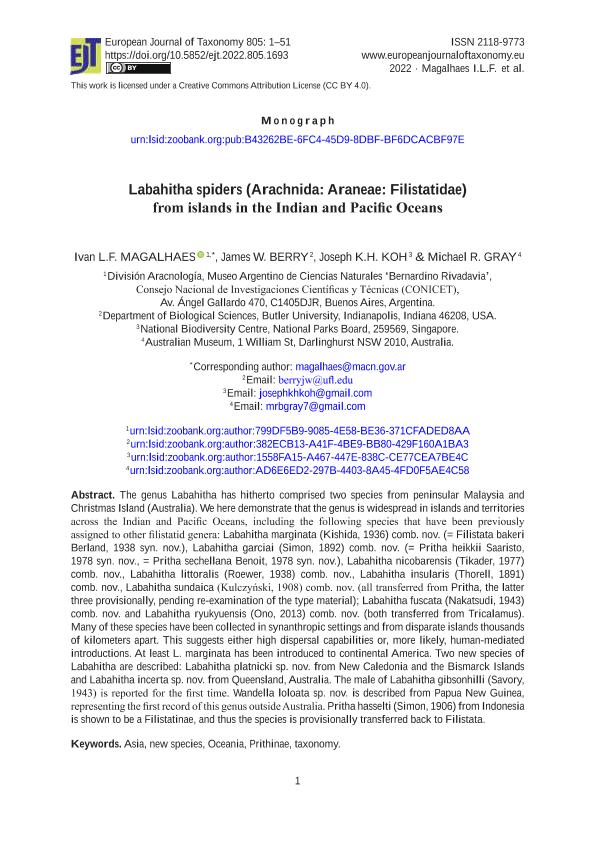Mostrar el registro sencillo del ítem
dc.contributor.author
Fiorini de Magalhaes, Ivan Luiz

dc.contributor.author
Berry, James W.
dc.contributor.author
Koh, Joseph K.H.
dc.contributor.author
Gray, Michael R.
dc.date.available
2023-10-26T12:04:46Z
dc.date.issued
2022-03
dc.identifier.citation
Fiorini de Magalhaes, Ivan Luiz; Berry, James W.; Koh, Joseph K.H.; Gray, Michael R.; Labahitha spiders (Arachnida: Araneae: Filistatidae) from islands in the Indian and Pacific Oceans; Museum National d'Histoire Naturelle; European Journal of Taxonomy; 805; 3-2022; 1-51
dc.identifier.issn
2118-9773
dc.identifier.uri
http://hdl.handle.net/11336/216018
dc.description.abstract
The genus Labahitha has hitherto comprised two species from peninsular Malaysia and Christmas Island (Australia). We here demonstrate that the genus is widespread in islands and territories across the Indian and Pacific Oceans, including the following species that have been previously assigned to other filistatid genera: Labahitha marginata (Kishida, 1936) comb. nov. (= Filistata bakeri Berland, 1938 syn. nov.), Labahitha garciai (Simon, 1892) comb. nov. (= Pritha heikkii Saaristo, 1978 syn. nov., = Pritha sechellana Benoit, 1978 syn. nov.), Labahitha nicobarensis (Tikader, 1977) comb. nov., Labahitha littoralis (Roewer, 1938) comb. nov., Labahitha insularis (Thorell, 1891) comb. nov., Labahitha sundaica (Kulczyński, 1908) comb. nov. (all transferred from Pritha, the latter three provisionally, pending re-examination of the type material); Labahitha fuscata (Nakatsudi, 1943) comb. nov. and Labahitha ryukyuensis (Ono, 2013) comb. nov. (both transferred from Tricalamus). Many of these species have been collected in synanthropic settings and from disparate islands thousands of kilometers apart. This suggests either high dispersal capabilities or, more likely, human-mediated introductions. At least L. marginata has been introduced to continental America. Two new species of Labahitha are described: Labahitha platnicki sp. nov. from New Caledonia and the Bismarck Islands and Labahitha incerta sp. nov. from Queensland, Australia. The male of Labahitha gibsonhilli (Savory, 1943) is reported for the first time. Wandella loloata sp. nov. is described from Papua New Guinea, representing the first record of this genus outside Australia. Pritha hasselti (Simon, 1906) from Indonesia is shown to be a Filistatinae, and thus the species is provisionally transferred back to Filistata.
dc.format
application/pdf
dc.language.iso
eng
dc.publisher
Museum National d'Histoire Naturelle
dc.rights
info:eu-repo/semantics/openAccess
dc.rights.uri
https://creativecommons.org/licenses/by/2.5/ar/
dc.subject
ASIA
dc.subject
NEW SPECIES
dc.subject
OCEANIA
dc.subject
PRITHINAE
dc.subject
TAXONOMY
dc.subject.classification
Zoología, Ornitología, Entomología, Etología

dc.subject.classification
Ciencias Biológicas

dc.subject.classification
CIENCIAS NATURALES Y EXACTAS

dc.title
Labahitha spiders (Arachnida: Araneae: Filistatidae) from islands in the Indian and Pacific Oceans
dc.type
info:eu-repo/semantics/article
dc.type
info:ar-repo/semantics/artículo
dc.type
info:eu-repo/semantics/publishedVersion
dc.date.updated
2023-10-25T12:53:44Z
dc.journal.volume
805
dc.journal.pagination
1-51
dc.journal.pais
Francia

dc.description.fil
Fil: Fiorini de Magalhaes, Ivan Luiz. Consejo Nacional de Investigaciones Científicas y Técnicas. Oficina de Coordinación Administrativa Parque Centenario. Museo Argentino de Ciencias Naturales "Bernardino Rivadavia"; Argentina
dc.description.fil
Fil: Berry, James W.. Butler University; Estados Unidos
dc.description.fil
Fil: Koh, Joseph K.H.. National Biodiversity Centre; Singapur
dc.description.fil
Fil: Gray, Michael R.. Australian Museum; Australia
dc.journal.title
European Journal of Taxonomy
dc.relation.alternativeid
info:eu-repo/semantics/altIdentifier/url/https://europeanjournaloftaxonomy.eu/index.php/ejt/article/view/1693
dc.relation.alternativeid
info:eu-repo/semantics/altIdentifier/doi/http://dx.doi.org/10.5852/ejt.2022.805.1693
Archivos asociados
